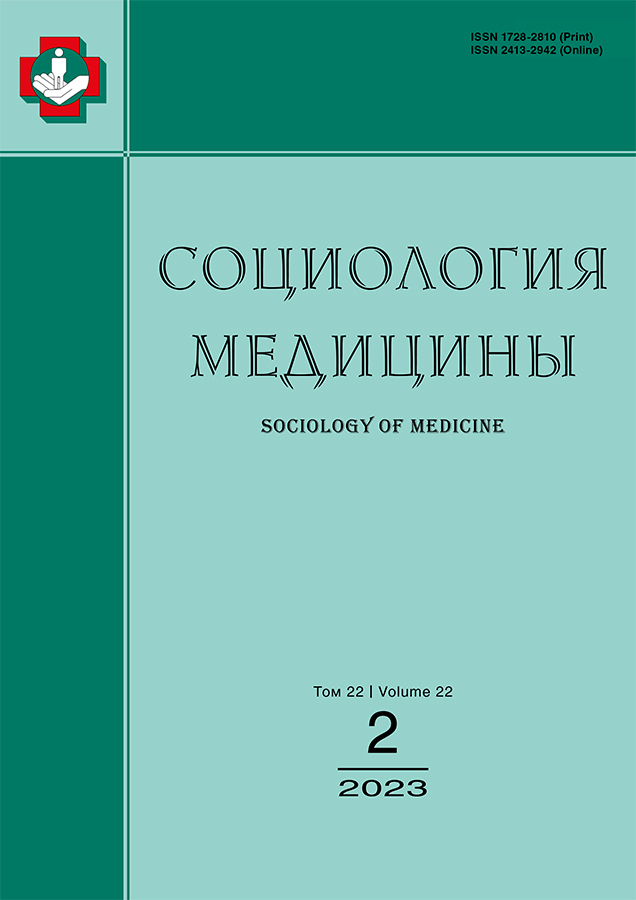Features of the social structure of feldshers of feldsher-obstetric stations (on the example of the Nizhny Novgorod region)
- Authors: Shchukin S.V.1, Abaeva O.P.2
-
Affiliations:
- Territorial part of the Federal Service for Supervision of Healthcare in the Nizhny Novgorod region
- The First Sechenov Moscow State Medical University
- Issue: Vol 22, No 2 (2023)
- Pages: 176-182
- Section: SOCIOLOGY OF MEDICAL PROFESSION
- URL: https://rjsocmed.com/1728-2810/article/view/568790
- DOI: https://doi.org/10.17816/socm568790
- ID: 568790
Cite item
Abstract
BACKGROUND: The health indicators of the rural population of our country are worse than those of urban residents. An important link in the protection of the health of the rural population are feldshers and obstetric stations, the main problem of which is the shortage of personnel.
AIM: The purpose of the study is to identify the features of the social structure of feldshers of feldshers-obstetric stations that affect the formation of the personnel of this health care unit at the present stage.
METHODS: The study was conducted based on the materials of a questionnaire survey of 122 feldshers of the feldsher-obstetric stations of the Nizhny Novgorod region. The survey provided for obtaining information about the age, gender, duration of work, and the age of commencement of work of feldshers directly in the feldsher-obstetric centers.
RESULTS: The results showed the predominance of women (95.1±2.0%). The proportion of feldshers aged 50 to 54 years was the largest in the age structure — 25.0±4.0%, as well as the previous and subsequent age groups: from 45 to 49 years — 13.1±3.0%, from 55 to 59 years — 13.9± 3.1%. According to the duration of work in feldsher-obstetric centers, specialists with work experience from 30 to 34 years prevail — 41.5±4.4%. There is a tendency to employ specialists with work experience in feldsher-obstetric centers: with a minimum number of feldshers in the age groups of 20–24 years and 25–29 years, there is a fairly significant proportion of specialists with little work experience: from 0 to 4 years — 13.9± 3.1%, from 5 to 9 years — 10.7±2.7%; only 58.2% of the survey participants reported that they started working in a feldshers -obstetric center at the age of 20 to 24 years.
CONCLUSION: The most important feature of the social structure of feldshers of feldsher-obstetric stations is the sharp predominance of women, an extremely low proportion of specialists of young age groups, while the formation of personnel is carried out through the processes of professional migration from other departments of district hospitals or other medical organizations, and not through the employment of college graduates.
Full Text
About the authors
Sergey V. Shchukin
Territorial part of the Federal Service for Supervision of Healthcare in the Nizhny Novgorod region
Email: meda224@mail.ru
ORCID iD: 0009-0008-9591-3596
Russian Federation, Nizhny Novgorod
Olga P. Abaeva
The First Sechenov Moscow State Medical University
Author for correspondence.
Email: abaevaop@inbox.ru
ORCID iD: 0000-0001-7403-7744
SPIN-code: 5602-2435
MD, Dr. Sci. (Medicine), Professor
Russian Federation, MoscowReferences
- Lazarev AV, Kizeev MV, Kalininskaya AA, et al. Health and demographic situation in the rural Russia. Health care Standardization Problems. 2022;(7-8):18-24. EDN: ENXHHL doi: 10.26347/1607-2502202207-08018-024
- Gadzhiev RS, Agalarova LS. The volume and the nature of outpatient care to rural population and ways of its optimization. Public Health and Health Care. 2018;3(59):71-77. EDN: YMSBOH
- Kalininskaya AA, Bakirova EA, Kizeev MV, et al. The problems of rural health care and prospects of development. The problems of social hygiene, public health and history of medicine. 2022;30(6):1224-1229. EDN: UKCQAT doi: 10.32687/0869-866X-2022-30-6-1224-1229
- Kalininskaia AA, Baianova NA. The territorial accessibility of primary preliminary medical sanitary care of rural population. The problems of social hygiene, public health and history of medicine. 2018;26(5):328-332. EDN: YQZGMP doi: 10.32687/0869-866X-2018-26-5-328-332
- Enikeyev OA, Enikeyeva SA. Legal regulation of paramedic-obstetric centers. Vestnik of Saint Petersburg University. Law. 2022;13(4):947-962. EDN: ALIJCF doi: 10.21638/spbu14.2022.407
- Reshetnikov AV. The evolution of sociology of medicine. Sociology of Medicine. 2012;2(21):4-10. EDN: RADFXV
- Kalininskaya AA, Muftakhova AV, Bayanova NA, Sulkina FA. Health condition of a rural population living in different areas of medical aid accessibility. Manager Zdravoochranenia. 2019;(8):55-61. EDN: UZLHAI
- Tarychev VV. Scientific substantiation of ways to improve the management of paramedic emergency medical personnel (on the example of the city of Nizhny Novgorod) [dissertation abstract]. Moscow, 2013. 158 p. (In Russ.) EDN: SULKEV
- Krom IL, Erugina MV, Eremina MG, Sapogova MD, Subbotina VG. Medical and sociological analysis of the quality of life in rural physicians. Saratov Journal of Medical Scientific Research. 2022;18(2):256–260. EDN: MKLSQY
- Romanova TE, Abaeva OP, Romanov SV. Attitude of doctors and patients of the central district hospital to using digital health technologies (based on the results of a medical and sociological study). Saratov Journal of Medical Scientific Research. 2023;19(2):180-183. EDN: VZKLJJ doi: 10.15275/ssmj1902180
- Boyev VS, Ushakova LV. The functioning of feldsher-midwife stations. Problems of Social Hygiene, Public Health and History of Medicine. 2012;(3):41-44. EDN: RBXTLN
- Romanovskaja SV, Kukovjakina ND, Kukovjakin SA, Muhachjova EA. Problems of management in supervising of obstetrics stations. Vyatka Medical Bulletin. 2012;(1):36-39. EDN: OWMFNN
- Yagudin RKh, Rybkin LI, Sibgatullina AF, Idelbayebva FM. Medical attendant-obstetric stations under modern conditions of rendering medical aid to rural population. Practical medicine. 2014;1(4):178-181. EDN: SKAXWB
- Gadzhiev RS, Agalarova LS, Ragimov GG. Improving the organization of labor and quality of medical care at paramedic-obstetric stations. The problems of social hygiene, public health and history of medicine. 2022;30(5):859-864. EDN: BXNGTN doi: 10.32687/0869-866X-2022-30-5-859-864
Supplementary files









